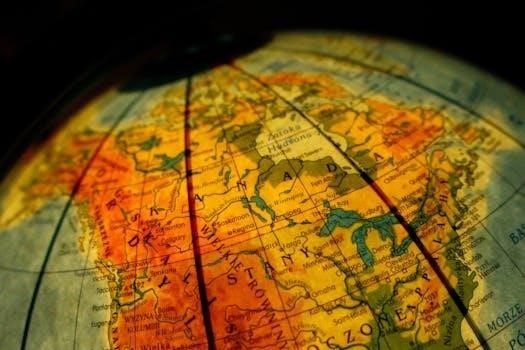
World history timelines are essential tools for visualizing the vast expanse of human history. They offer a chronological framework, aiding in the comprehension of events from ancient civilizations to modern times, often found in PDF format for easy access.
The Significance of Timelines in Studying History
Timelines serve as crucial educational instruments in the study of world history, offering a clear and structured pathway to understanding the past. They facilitate the visualization of historical events, allowing learners to grasp the chronological order and relationships between different periods and occurrences. By providing a sequential framework, timelines assist in comprehending the progression of human civilization, from ancient empires to modern global dynamics. Furthermore, they highlight the interconnectedness of events, regions, and cultures, promoting a more holistic understanding of history. The availability of world history timelines in PDF format enhances their accessibility, making them a valuable resource for students, educators, and history enthusiasts. These timelines not only aid in memorization but also in fostering analytical thinking by identifying patterns and trends across different eras.

Types of World History Timelines
World history timelines come in various forms, including comprehensive overviews, focused regional timelines, and those designed for specific educational needs. PDF formats offer convenient access to these different types.
Comprehensive Timelines Covering Millions of Years
Comprehensive world history timelines, often available as downloadable PDFs, undertake the monumental task of charting events across vast stretches of time, sometimes spanning millions of years. These timelines typically begin with the emergence of early humans and extend to the present day, encompassing the development of civilizations, empires, and significant global shifts. They provide a broad overview, placing specific historical periods within a larger context. Such timelines can include major geological changes, the evolution of life, and the rise and fall of countless societies. They often integrate both historical and pre-historical events, presenting a holistic view of our planet’s story. These resources are invaluable for understanding the long-term trajectory of human and earthly development.
Timelines Focused on Specific Eras or Regions
In contrast to comprehensive timelines, many world history PDFs focus on specific eras or geographical regions, offering a more in-depth analysis. These timelines allow for a closer examination of particular time periods, such as the classical age or the industrial revolution, or specific areas such as ancient Egypt or the Roman Empire. By narrowing the scope, these timelines can include more detailed information about cultural, political, and social developments within a defined context. They often include maps, illustrations, and summaries of key events. These resources are essential for students, researchers, and history enthusiasts seeking to deepen their understanding of specific areas or periods of interest. Such timelines offer a valuable tool for specialized historical study.
Timelines for Specific Educational Purposes
World history timelines are often created for specific educational purposes, tailored to different age groups and learning objectives. These PDFs can be designed to align with curriculum standards, focusing on key events and figures relevant to a particular course. They may include simplified layouts for younger learners or more detailed information for advanced studies. Some educational timelines include interactive elements or activities to enhance engagement and comprehension. Resources like these are invaluable for both teachers and students, providing a structured approach to learning and visualizing the flow of history. They are also useful for homeschool environments, where flexible resources are essential. These timelines can be downloaded and printed for classroom use or individual study, making history accessible to all.

Key Elements in World History Timelines
Key elements in world history timelines include a chronological arrangement of events, the inclusion of major civilizations and empires, and coverage of significant discoveries, all of which are readily available in PDF format.
Chronological Arrangement of Events
The bedrock of any effective world history timeline is its chronological arrangement of events. This structure ensures that historical occurrences are placed in their proper sequence, allowing for a clear understanding of cause and effect. Timelines, often accessed in PDF format, meticulously order events from the most ancient to the most recent, creating a linear progression. This arrangement is crucial for grasping the development of civilizations, the rise and fall of empires, and the progression of human innovation. The chronological approach also enables users to trace specific themes or trends across time, offering a dynamic perspective on historical change, making them invaluable tools for educators and students. The clarity afforded by this sequencing is paramount for both learning and research.
Inclusion of Major Civilizations and Empires
A critical aspect of world history timelines, particularly those in PDF format, is the inclusion of major civilizations and empires. These timelines meticulously chart the rise, reign, and decline of significant societies, from ancient Egypt and Rome to the vast empires of Asia and the Americas. They illustrate the geographical reach, political structures, and cultural contributions of these powerful entities; This inclusion provides a comparative view of different societies, highlighting both their unique characteristics and their interconnectedness. By mapping these civilizations and empires chronologically, timelines offer a vital perspective on the evolution of human societies, aiding in understanding their lasting impact on the world.
Coverage of Significant Discoveries and Inventions
World history timelines, especially those available in PDF format, are crucial for demonstrating the impact of significant discoveries and inventions. These timelines meticulously document technological advancements, scientific breakthroughs, and artistic innovations across different periods and regions. From the development of agriculture and the wheel to the invention of the printing press and the internet, these timelines illustrate how human ingenuity has shaped societies. They highlight how discoveries and inventions, often originating in specific geographical locations, have diffused across the globe, leading to both progress and social transformation. By displaying these innovations within their historical context, timelines allow for a deeper understanding of their profound influence on the course of human history and civilization.

Resources for World History Timelines
Numerous resources offer world history timelines, often in PDF format. These include printable timelines for educational use, digital interactive timelines, and books with detailed historical chronologies.
Printable PDF Timelines for Educational Use
Printable PDF timelines are a valuable resource for educators and students, offering a tangible way to visualize the flow of world history. These timelines often come in various formats, from comprehensive charts spanning millennia to focused timelines highlighting specific eras. They are easily downloadable and can be printed for classroom use, homework assignments, or personal study. The convenience of PDF format allows for easy sharing and accessibility. Many resources offer free printable timelines, catering to different educational levels and subject matter. These timelines frequently include key historical events, significant figures, and major turning points in world history, making them an effective tool for learning and review. The format allows students to mark and annotate key dates, aiding in comprehension and retention. These readily available resources are essential for both homeschooling and traditional educational settings, providing a flexible and user-friendly approach to learning history.
Digital Timelines for Interactive Learning
Digital timelines offer a dynamic and engaging approach to learning world history, moving beyond the limitations of static printed formats. These interactive timelines often feature clickable events, multimedia elements, and zoom capabilities, allowing users to explore history in a more immersive way. Digital platforms can incorporate maps, images, videos, and audio clips, enhancing the learning experience and catering to different learning styles. They offer the flexibility to navigate through history at one’s own pace, exploring specific periods or events in detail. Many digital timelines are web-based, ensuring accessibility across various devices, and some are available as downloadable interactive PDFs. These platforms often include search functionalities, making it easier to find specific information within the timeline. This interactive approach helps students develop a deeper understanding of historical contexts and connections. The adaptability and multimedia capabilities of digital timelines make them a powerful tool for both formal and informal learning environments.
Book Resources Featuring Detailed Timelines
Numerous book resources provide comprehensive world history timelines, offering in-depth chronological accounts of significant events. These books often present timelines alongside detailed narratives, contextualizing events within their respective historical periods. Many publications include visual aids such as maps, illustrations, and photographs to enhance understanding. Books dedicated to world history timelines may cover broad spans of time, from prehistory to the modern era, or focus on specific regions, periods, or themes. Some resources organize events by century or era, providing a structured approach to historical study. These books vary in complexity, catering to different educational levels and interests, from introductory overviews to advanced academic texts. Many are available in print, and some are also offered in digital formats, like PDF, allowing for convenient access. These resources often serve as valuable references for students, educators, and history enthusiasts, providing a structured and detailed exploration of world history through timelines.

Using Timelines for Historical Understanding
Timelines are crucial for understanding historical flow, connecting events across regions, and identifying cause-and-effect relationships. They offer a visual framework for grasping the complexities of world history.
Visualizing the Flow of Historical Events
Timelines provide a clear, visual representation of the order in which historical events occurred, allowing us to see the progression of human civilization. From the earliest empires to the modern era, timelines help us understand how one event led to another. They reveal patterns and trends that might be missed when studying isolated moments in history. The use of timelines, especially in PDF format, allows for a tangible and easily accessible method for reviewing the rise and fall of civilizations, the spread of ideas, and the impact of major discoveries. By arranging events chronologically, timelines simplify complex narratives and make it easier to visualize the flow of history.
Connecting Events Across Different Regions
World history timelines, especially in PDF format, are indispensable for connecting events that transpired in disparate regions of the globe. By juxtaposing occurrences from different areas side-by-side, they reveal the interconnected nature of world history. We can see how technological advancements in one region might have influenced developments in another, or how the rise of empires in one area correlated with changes in others. These timelines provide a framework for understanding the global impact of local events, highlighting the complex web of interactions and exchanges that have shaped our world. This interconnectedness is often missed in regional studies, making timelines an essential tool for seeing the bigger picture.
Understanding Cause and Effect in History
World history timelines, often available in downloadable PDF format, serve as crucial aids in understanding the cause and effect relationships that have shaped the course of history. These timelines allow us to see how one event can trigger a series of subsequent developments. By placing events in chronological order, we can analyze how specific actions or circumstances led to significant outcomes. For example, a timeline can illustrate how the invention of the printing press influenced the Reformation, or how certain political decisions led to major wars. This ability to visualize the sequential progression of events makes timelines indispensable for historical analysis, enabling a deeper comprehension of historical processes. They help us grasp the interconnected web of actions and consequences that define human history.

